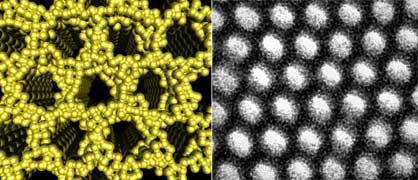Self-assembling Nanometals May Improve Fuel Cells, Microchips
Source: Dailytech
Cornell University researchers have found a way to assemble metals, platinum in this case, into a useful structure. Their work utilizes a co-polymer, a ligand and the metal particles themselves. Scientists have been chasing self-assembling metals via co-polymers for years, but it’s the addition of the ligand, which is used to facilitate a high density solution of metal particles, that makes this process work.
Once the solution is made, it is mixed with the co-polymer. Co-polymers form known and reliable structures and the scientists utilized this to create their final metallic structures. The platinum molecules combine with a single polymer in the mixture, which allows them to take on a shape controlled by the other polymer’s structure. For their tests, the Cornell researchers created a hexagonal honeycomb type structure out of the platinum nanoparticles.
Once the material has taken shape, it is annealed in an airless environment, which also turns the polymers into a carbon scaffolding. High temperatures are then used to burn away the carbon and oxidize the ligand. The metal particles melt on the exterior, allowing them to fuse together into a solid structure as the carbon scaffolding and ligand chemicals disappear.


Recent Comments